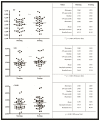Comparison of 15-20 mmHg versus 20-30 mmHg Compression Stockings in Reducing Occupational Oedema in Standing and Seated Healthy Individuals
- PMID: 30364041
- PMCID: PMC6188858
- DOI: 10.1155/2018/2053985
Comparison of 15-20 mmHg versus 20-30 mmHg Compression Stockings in Reducing Occupational Oedema in Standing and Seated Healthy Individuals
Abstract
Background: Elastic compression stockings (ECS) are effective in preventing and reducing occupational edema (OE), but the optimal pressure according to the prevalent working position during the day is still controversial.
Objective: To compare the effectiveness of ECS with different pressures (15-20 mmHg or 20-30 mmHg) for reducing OE in individuals working in different prolonged postures.
Methods: This cross-sectional study comprised 116 lower limbs of 58 individuals divided into three groups according to their prevalent postures over the day (sitting, standing, or combination). Volumetric measurements were taken at the beginning and at the end of three consecutive days. On the first day, individuals did not use compression stockings; on the second and third days, they used, respectively, 15-20 mmHg and 20-30 mmHg knee-length stockings. Differences between morning and evening volumes (measured edema) were calculated, compared, and correlated.
Results: Volumetric variations were significantly lower on the second compared to the first day when individuals in all three groups used 15-20 mmHg compression stockings (p-value < 0.001). Measurements were even lower when they used 20-30 mmHg stockings: this decrease was more significant for the sitting (p-value < 0.001) than the standing (p-value < 0.05) and combined groups (p-value < 0.05). Reduction of measured edema was more significant in individuals working in a prolonged seated position. No significant difference was found only on comparing sitting and standing groups after the use of the 15-20 mmHg compression stockings.
Conclusions: The use of ECS over a working day reduces OE in prolonged sitting, standing, and combined positions, with the reductions being greater with the higher pressure.
Figures



Similar articles
-
Comparison of Physiological Effects Induced by Two Compression Stockings and Regular Socks During Prolonged Standing Work.Hum Factors. 2023 Jun;65(4):562-574. doi: 10.1177/00187208211022126. Epub 2021 Jun 2. Hum Factors. 2023. PMID: 34078143 Free PMC article.
-
Occupational leg oedema is more reduced by antigraduated than by graduated stockings.Eur J Vasc Endovasc Surg. 2013 May;45(5):523-7. doi: 10.1016/j.ejvs.2013.01.032. Epub 2013 Feb 20. Eur J Vasc Endovasc Surg. 2013. PMID: 23433949
-
Compression stockings reduce occupational leg swelling.Dermatol Surg. 2004 May;30(5):737-43; discussion 743. doi: 10.1111/j.1524-4725.2004.30204.x. Dermatol Surg. 2004. PMID: 15099316
-
Occupational leg edema-use of compression stockings.Porto Biomed J. 2020 Nov 24;5(6):e093. doi: 10.1097/j.pbj.0000000000000093. eCollection 2020 Nov-Dec. Porto Biomed J. 2020. PMID: 33283063 Free PMC article. Review.
-
Post-treatment compression: duration and techniques.Phlebology. 2013 Mar;28 Suppl 1:21-4. doi: 10.1177/0268355513475955. Phlebology. 2013. PMID: 23482529 Review.
Cited by
-
Comparison of Physiological Effects Induced by Two Compression Stockings and Regular Socks During Prolonged Standing Work.Hum Factors. 2023 Jun;65(4):562-574. doi: 10.1177/00187208211022126. Epub 2021 Jun 2. Hum Factors. 2023. PMID: 34078143 Free PMC article.
-
The Use of Compression Stockings to Reduce Water Retention in the Legs During Gaming and Esports: Randomized Controlled Field Study.Interact J Med Res. 2022 Sep 29;11(2):e25886. doi: 10.2196/25886. Interact J Med Res. 2022. PMID: 36173666 Free PMC article.
-
Prolonged Sitting Causes Leg Discomfort in Middle Aged Adults: Evaluation of Shear Wave Velocity, Calf Circumference, and Discomfort Questionaries.J Clin Med. 2022 Jul 12;11(14):4024. doi: 10.3390/jcm11144024. J Clin Med. 2022. PMID: 35887787 Free PMC article.
-
Effect of prolonged sitting immobility on shear wave velocity of the lower leg muscles in healthy adults: A proof-of-concept study.PLoS One. 2021 May 10;16(5):e0251532. doi: 10.1371/journal.pone.0251532. eCollection 2021. PLoS One. 2021. PMID: 33970970 Free PMC article. Clinical Trial.
-
Evaluation of the effectiveness of wearing compression stockings for prevention of occupational edema in hairdressers.J Vasc Bras. 2020 Mar 6;19:e20190028. doi: 10.1590/1677-5449.190028. J Vasc Bras. 2020. PMID: 34178050 Free PMC article.
References
-
- Pirnat L. Systematic studies of the varicose symptom complex in industry. Zentralbl Phlebol. 1967;6:265–275. - PubMed
LinkOut - more resources
Full Text Sources

